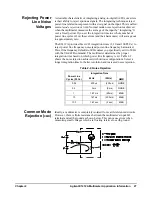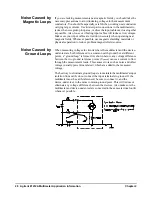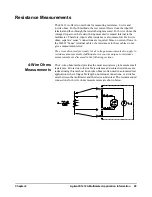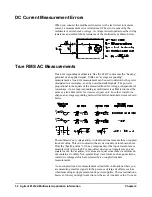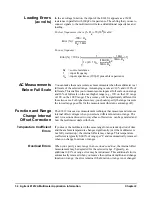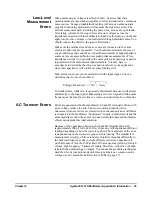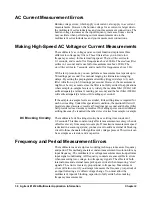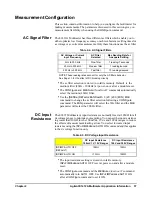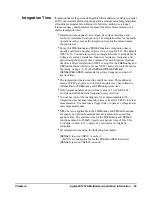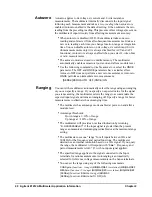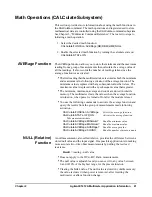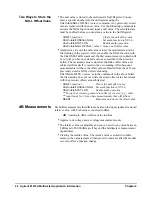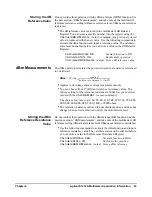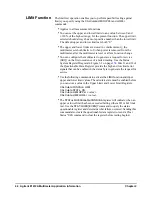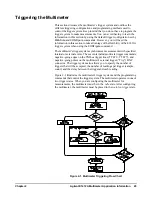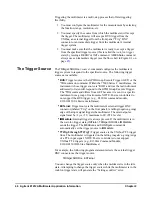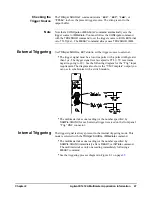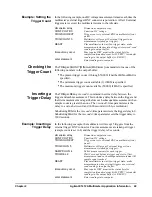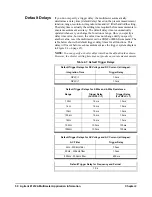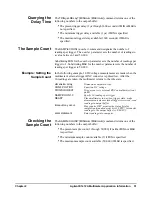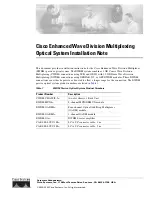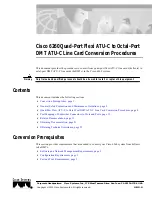
Agilent E1412A Multimeter Application Information
41
Math Operations (CALCulate Subsystem)
This sections provides more information about using the math functions in
the
CALCulate
command. The math operations and registers used to store
mathematical data are controlled using the
CALCulate
command subsystem.
See Chapter 3, “Multimeter Command Reference”. There are two steps to
initiating a math operation.
1. Select the desired math function:
CALCulate:FUNCtion AVERage|DB|DBM|LIMit|NULL
2. Enable the selected math function by turning the calculate state on:
CALCulate:STATe ON
AVERage Function
The
AVERage
function allows you to store the minimum and the maximum
reading from a group of measurements then calculate the average value of
all the readings. It also records the number of readings taken since the
average function was activated.
•
The first reading that the multimeter takes is stored as both the minimum
and maximum value following activation of the average function. The
minimum value is replaced with any subsequent value that is less. The
maximum value is replaced with any subsequent value that is greater.
•
The minimum, maximum, average and count are stored in volatile
memory. The multimeter clears the values when the average function
is turned on, when power is turned off or after the module is reset.
•
You use the following commands to activate the average function and
query the results from the group of measurements made following
activation.
CALCulate:FUNCtion AVERage
Selects the average function.
CALCulate:STATe OFF|ON
Activates the average function.
Take measurements here.
CALCulate:AVERage:MINimum?
Read the minimum value.
CALCulate:AVERage:MAXimum?
Read the maximum value.
CALCulate:AVERage:AVERage?
Read the average value.
CALCulate:AVERage:COUNt?
Read the number of measurements.
NULL (Relative)
Function
A null measurement, also called relative, provides the difference between a
stored null value and the input signal. One possible application is in making
more accurate two-wire ohms measurements by nulling the test lead
resistance.
Result
= reading - null value
•
Does not apply to the DC-to-DC Ratio measurements.
•
The null value is adjustable and you can set it to any value between
0 and
120% of the highest range, for the present function.
•
Clearing the
NULL
value. The null value is stored in volatile memory;
the value is cleared when power is removed, after resetting the
multimeter or after a function change.
Summary of Contents for Agilent E1412A
Page 2: ......
Page 10: ...8 Contents Notes...
Page 14: ...12 Notes...
Page 15: ...13 Notes...
Page 16: ...14 Notes...
Page 26: ...24 Agilent E1412A Multimeter Module Setup Chapter 1 Notes...
Page 194: ...192 Agilent E1412A Multimeter Error Messages Appendix B Notes...
Page 201: ...Index 199 Index Agilent E1412A User s Manual and SCPI Programming Guide...

